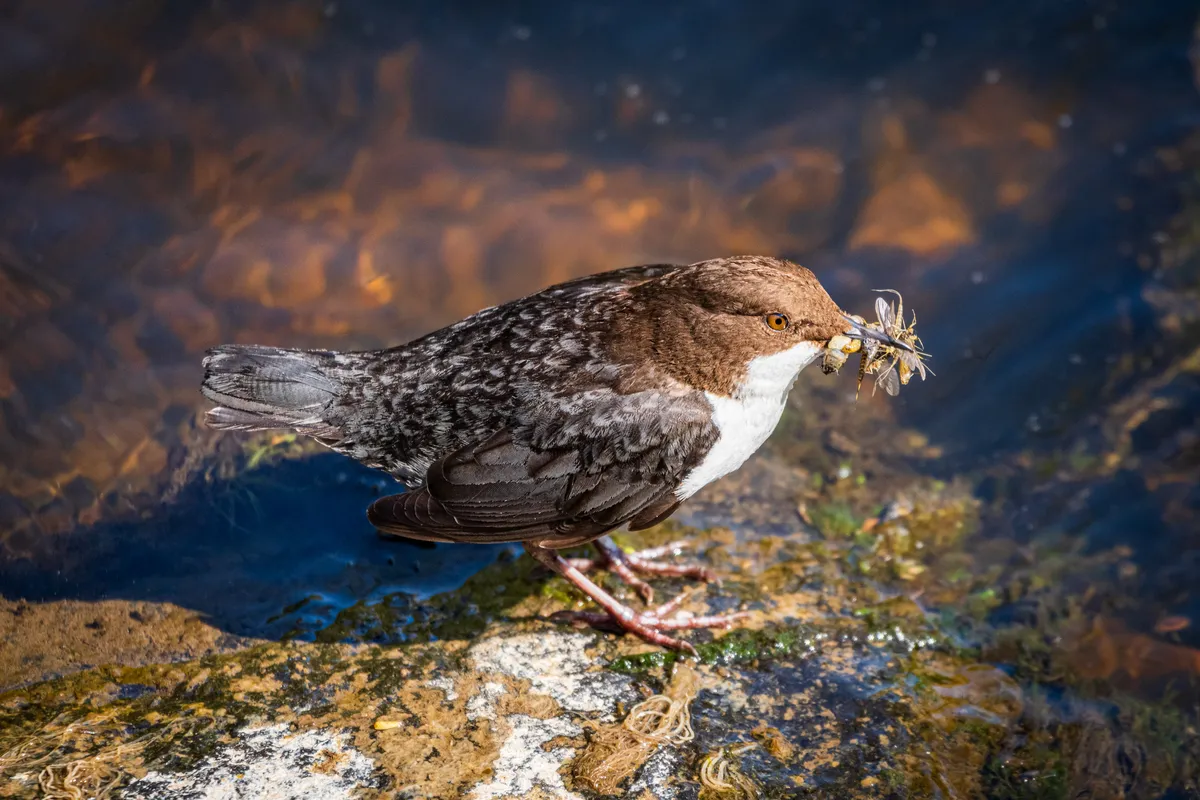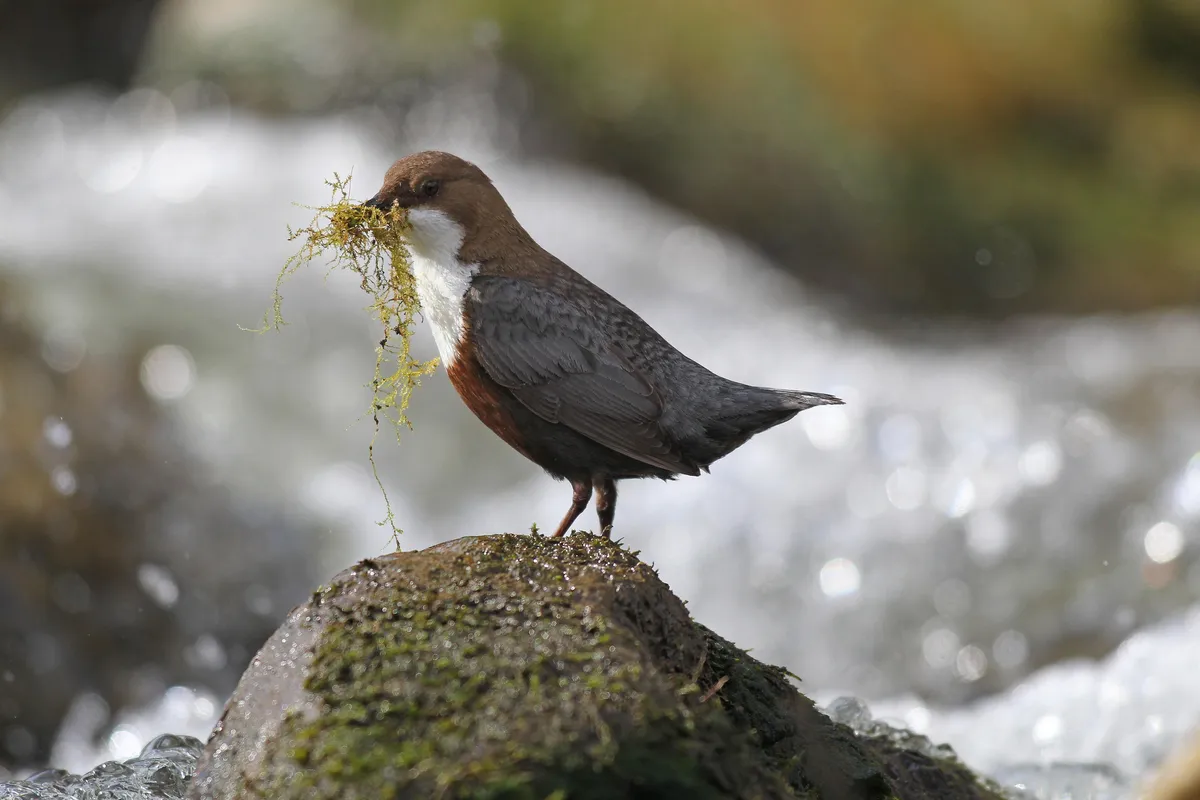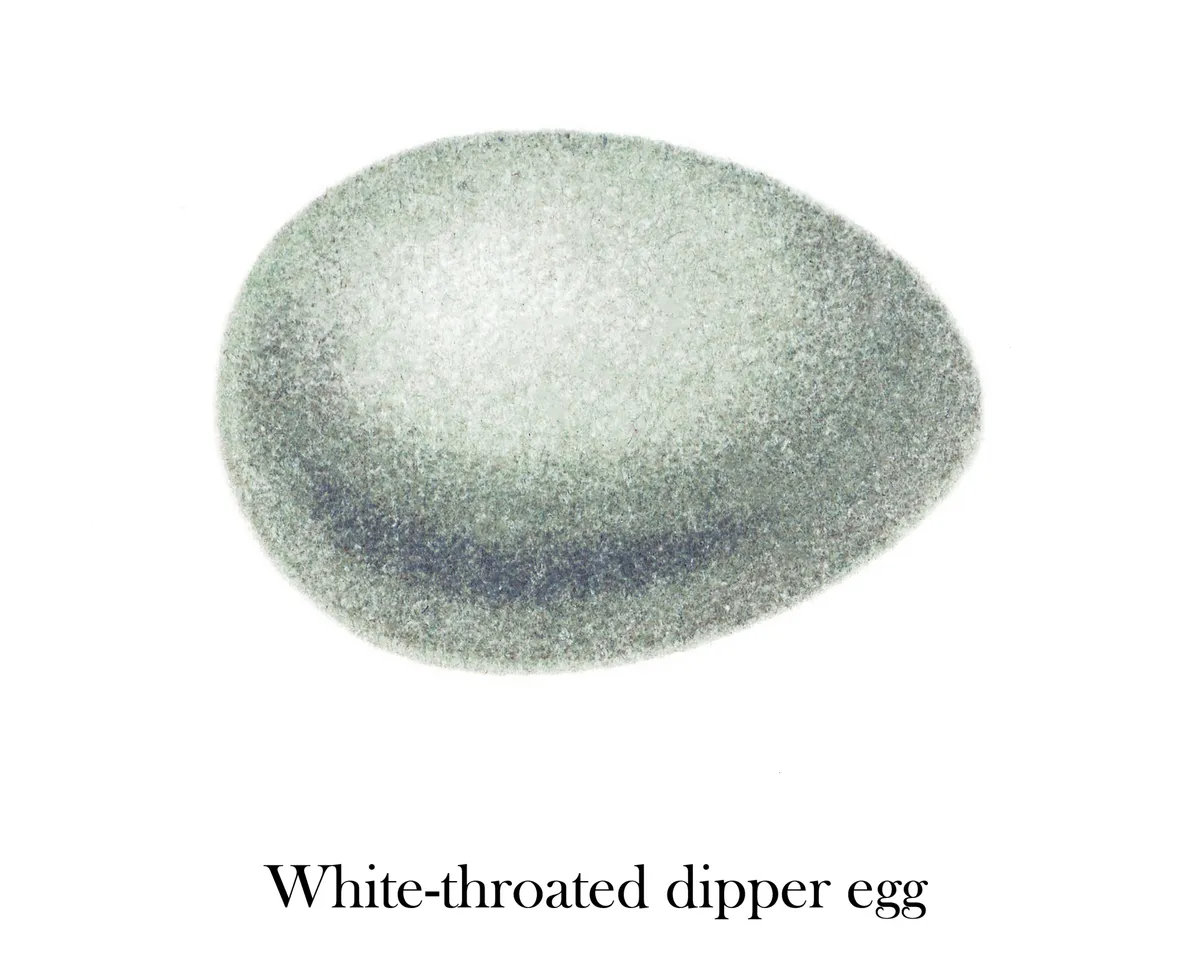Britain has its share of tail-wagging, head-flicking birds, but nothing dips quite like a dipper. New evidence is providing us with fresh understanding of the species, but do we have the answer to that nagging question: why does the dipper dip?
Looking into the maelstrom of an upland stream, our eyes go white-water rafting over the rapids and our ears are overwhelmed by a roaring, hissing torrent. Even though our senses are drowned, our attention is grabbed by a diminutive figure on its little boulder of a stage – a bob, a curtsey, the up and down flash of a white-breasted bird, a wren-like cock of the tail.
What is the scientific name of the dipper?
The scientific name of the dipper is Cinclus cinclus.
This is an example of a tautonym, where the genus and species name are the same.
Known in the UK and British Isles just as ‘dipper’, the white-throated or European dipper is Cinclus genus, which also contains four other species: brown dipper (Cinclus pallasii), American dipper (Cinclus mexicanus), white-capped dipper (Cinclus leucocephalus), and rufous-throated dipper (Cinclus schulzii).
Why do dippers bob up and down?

Many scientists offer the slightly unnerving thought that the dipper wants you to see it. In dipper-meets-dipper situations, the dip is a show of strength, a kind of ‘look how many bench presses I can do’. It draws the opposite sex, and it warns off a rival. And this is a display meant for others with more deadly intent. Just as a hare will stand up before a fox to let it know it’s been spotted, so the dipper dips to the binocular-clad figure on the bank. It’s as if it’s saying I’ve clocked you, so don’t think you can catch me.
If only things were this straightforward. An alternative theory for the dipper’s shtick argues the exact opposite. Both the dipper and the grey wagtail, with its erratic tail- bobbing, are – so the theory goes – making movements to blend in with the turbulence of their environment. A predator might spot an object that stays still, but cannot easily pinpoint it in a whole scene of permanent flux.
So just why does the dipper dip? It sounds like a joke and perhaps the joke is on us. Stephanie Tyler has studied dippers intensively for 40 years, longer than anyone else on the planet. She has watched all five species of this remarkable family, from the Himalayas to the Rocky Mountains and the rivers of South America.
Every one of them dips. What’s her conclusion? “It is the question I am asked more than any other. Everybody always asks me why they do it and there are all sorts of hypotheses, but nothing is really definite.” For all its fancy and, it seems, inexplicable dance moves, we name the dipper after one of its less impressive characteristics.
How do dippers swim?
The dipper looks an unlikely candidate for the claim to be ‘Britain’s only aquatic songbird’. It stands on its rock looking not so much like a streamlined submariner as an overfed blackbird, and it’s about the same size. However, freshwater biologist Steve Ormerod has worked on this species for 34 years and declares: “Dippers are just the most fantastically adapted organisms.”
Some of these adaptations are invisible. The bird has unusually high haemoglobin levels in its blood, enabling it to store large amounts of oxygen on underwater dives. A special flap seals its nose from inrushing water, and it has exceptionally well-developed muscles that control the shape of its lenses, helping it to surmount the visual difficulties of refraction in water.
Other adaptations can be felt by a scientist who has handled thousands of dippers in his career. Short but strong flipper-like wings beat the bird down to the bottom and then long toes with powerful claws act like crampons as it walks along on the stony river bed: “Those claws grip incredibly tightly, they squeeze very, very hard,” comments Ormerod, from uncomfortable experience.
Perhaps most remarkable of all is its wetsuit: “The feathers are extremely soft and dense,” says Ormerod. “A dipper might have one and a half times as many body feathers as a blackbird. And if I’m holding one in my hand, I always show people the enormous preen gland at the base of its tail that looks almost like an engorged tick.”
That preen gland means the dipper’s thick, well-oiled plumage traps thousands of air bubbles underwater, giving it a uniformly silver appearance and making it less visible to prey than its chocolate brown and brilliant white feathers might otherwise suggest. Bobbing up into open air again, it shivers pearly water droplets off in an instant. Its astonishing mermaid-like qualities allow it to slip between water and air as if there was no difference between them. Surging rapids might terrify us: the dipper appears totally fearless.
Does the dipper have a third eyelid?
In common with all other birds, the dipper has what is effectively a windscreen – a near-transparent third eyelid known as the nictitating membrane, which it draws across its eye. This membrane even acts like windscreen wipers, as it has the extra function of moistening and cleaning the front of the eye. Rapid blinks of this third eyelid while a bird is moving, especially when it is leaning over to feed or forage, suggest that it has an important role in protecting the eyes.
What do dippers eat?

For the most part, dippers hunt caddis and mayfly larvae, nymphs that are grazing algae on boulders and gravel. The larvae generally cling to the underside of rocks, where they find shelter from the currents, but no sanctuary from a hunting dipper. Some caddis larvae spin themselves silk webs to hide in. The mesh is torn apart and they are unceremoniously pulled out.
Other species are dragged from the water still wearing their protective casing of leaves or tiny pieces of twigs, woven together. Armour offers no defence; the dipper shells each caddis larva by beating it repeatedly against a stone. It’s as easy and messy as peeling a prawn – but they do it without fingers!

After three weeks of being fed in the nest, fledglings take to the river like a duck to raging water. Their first attempts at hunting for themselves can be hilarious to our eyes. They may beat out a caddis nymph from its case, then discard the grub and eat the case. Nevertheless, within 20–30 days, they are almost as good at walking through water as their parents. No small feat.
Where do dippers live?
The nature of dipper food makes this bird, in Stephanie Tyler’s words, “a fantastic indication of the quality of the aquatic environment”.
Many caddis and mayfly larvae live only in fast-flowing, well-oxygenated rivers. Mayflies are sensitive to changes in water quality, caddis flies to changes in sediment, and so the appearance or disappearance of dippers are symptomatic of changes in river quality. This bird has become the riverine equivalent of the canary in the coalmine.

The way we have treated and mistreated upland rivers through history has played out in the fortunes of dippers. Today there are some good news stories. In our post- industrial landscapes, dippers have been recolonising formerly grossly polluted waterways through towns and cities.
Lancastrian Steve Ormerod says with pride: “They’re in my home town of Burnley on the River Brun, which used to run orange with colliery waste. They’re also in South Wales, Teesside and in the middle of Sheffield.” Dippers have become everyday birds that can be seen by millions of people, for the first time in perhaps more than 150 years. It is something to be celebrated.
Where do dippers nest?
Dippers breed early in the year, often laying four or five eggs before the end of February.

They make a domed, mossy structure is often behind a waterfall, in a stone wall or in a crevice below a bridge.
What threats do dippers face?
The birds recolonising old haunts in conurbations are living with humans and receiving the by-products of our lifestyles – the sewer overflows from household waste and discharges from waste water treatment works. In tainted water, dippers are being exposed to new pollutants with ominous-sounding acronyms – PBDEs, the so-called flame retardants, as well as lingering residues of older PCBs. These are known endocrine-disrupters, affecting sex ratios (more male dippers are hatching), thyroid function, and fledgling development.
Equally worrying is the recently discovered evidence that microplastics are entering the food chain, since particles have been found in the bodies of aquatic insect larvae. What this means for dippers is yet to be ascertained and, since they rarely live more than two or three years, it would be hard to study long-term effects on an individual.
Even more disturbing is the fact that in rural river networks, dippers are still in decline. British Trust for Ornithology (BTO) figures show a nationwide fall in numbers of 30 per cent since 1970, a trend that shows no sign of reversing. Former threats from insecticides such as dieldrin have been replaced by new ones. Intensive poultry units are among the factors causing eutrophication, the depletion of oxygen in water, which kills aquatic animals. Fine sediment is entering rivers; it may, for example, be run- off from quad bike tracks, ploughing of riverside pastures to grow crops, or sheep or cattle encroaching into rivers.
Numbers of aquatic prey are falling in these degraded environments, and dipper populations are falling with them. A stretch of river that might have held four or five territories in the past, now holds one or two.
How do polluted water and a consequent reduction in the amount of prey play out in the life of a single dipper? Stuart Sharp of Lancaster University is leading research on rivers in the Yorkshire Dales to see how variation in water quality affects the lives of individual birds. “One aspect that we have been examining is how exposure to poor water quality in the nest affects a dipper’s life further down the road. For example, studies of other species in captivity show that poor diet early in life affects the quality of song. Dippers sing all year round and are highly territorial, so a poor singer would be less likely to acquire a mate or defend a territory.”
Main image: A dipper perching on a rock in Stonehaven, UK. © Andy Wilson/500px/Getty